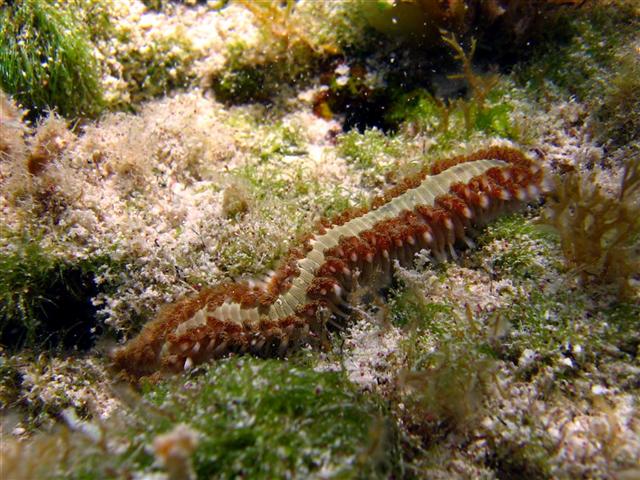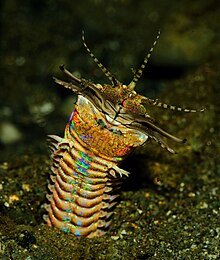Dry rock only - There are advantages to this. Obviously you would only have in the tank what you added. But for me, the disadvantages far outweigh that. Without seeing the worm he removed, I can only guess as to what it was or where it came from. But, I can tell you that in my tank, I have at least 3 easily distinguishable species of bristle worms (I spend a lot of time with a flashlight at night exploring) and none of them exceed 4 inches, though I know at least one of them can reach over a foot. Why do mine never get huge? Food. Like all the microfauna in our tanks, populations and adult size are resource limited. My guess is that the giant worm you mentioned was a common species such as E. complanata, and he simply overfeeds his tank, allowing them to grow large. Six Line wrasses also help keep them under control.
Remember though, Live rock is more than just a platform for bacteria. It is a vessel by which all sorts of creatures are introduced. On occasion, you may get one you don't want, such as aiptasia, or a mantis shrimp. But most of them are fantastic! I'm just going to list a few of the animals I have found and (at least roughly) identified, all introduced on live rock.
Stomatella varia snails.
Bristle worms
Peanut worms
Amphipods
Copepods
Mysid shrimp (now breeding like crazy in my fuge)
Collonista snails
Spaghetti worms
Chitons
Limpets
At least four types of Sponge
Feather dusters of all shapes, sizes and colors
Coralline algae in 4 colors
Isn't that worth the single aiptasia I got? Peppermint shrimp ate that quick enough. Buying only base rock and letting it "mature" on it's own may give you a darker colored rock in time, but it will never have the incredible biodiversity of LR purchased from different stores.
One thing about the Pukani rock. It's very light and porous, so the typical "1-2 lbs per gallon" rule can be fudged. It's also dry, and LR is weighed when wet. So 1 lb per gallon would be plenty if you went that route. The rocks will weight between 0.5 and 4 lbs each, based on their size. Great to use this stuff, but I really advise adding some LR too. Even if you have to buy... let's say 10 lbs of LR to start the tank and cycle, then buy a single fish and another rock. And so on until you have enough.
When cycling with shrimp, if you have only base rock, the shrimp will never go away and will need to be removed. If using LR, it will be eaten and you'll see an increase in microfauna populations.
Corals - for me, this is where saltwater shines. Many corals are actually very easy to care for and require little to no additional care. Especially softies. But as a general rule, for a reef tank, you need better lighting, higher flow, and lower nitrate.
In a FO or FOWLR tank, Nitrate up to 40 are fine, but for a reef, the lower the better. 0 is he holy grail of reef keeping. Mine hovers around 5 ppm. For soft corals, a single T5 HO bulb *may* be fine. Two T5 HO bulbs will allow you to keep even some LPS. I have 2 54 watt T5 HO bulbs, and I keep Hammer, frogspawn, torch, blastomussa, duncan, bubble, mushroom, kenya tree, zooanthid, galaxea, calustraea, and even a couple Montis.
Anemones are neither fish nor coral, but are related to corals. They are (like coral) cnidarians, posessing radial symmetry and a single body cavity with one opening used for both ingestion and excretion. With a few exceptions, anemone and coral are photosynthetic and derive energy from light. For a beginner anemone, I'd stick with the Bubble Tip (entacmea quadricolor), but don't get one now. Wait at least 6 months, preferably longer, for the tank to mature, as they are very sensitive animals.
As an aside, mushroom corals are not really corals either. They are their own class, called corallimorphs, and are somewhere between coral and anemone, possessing qualities of both.



